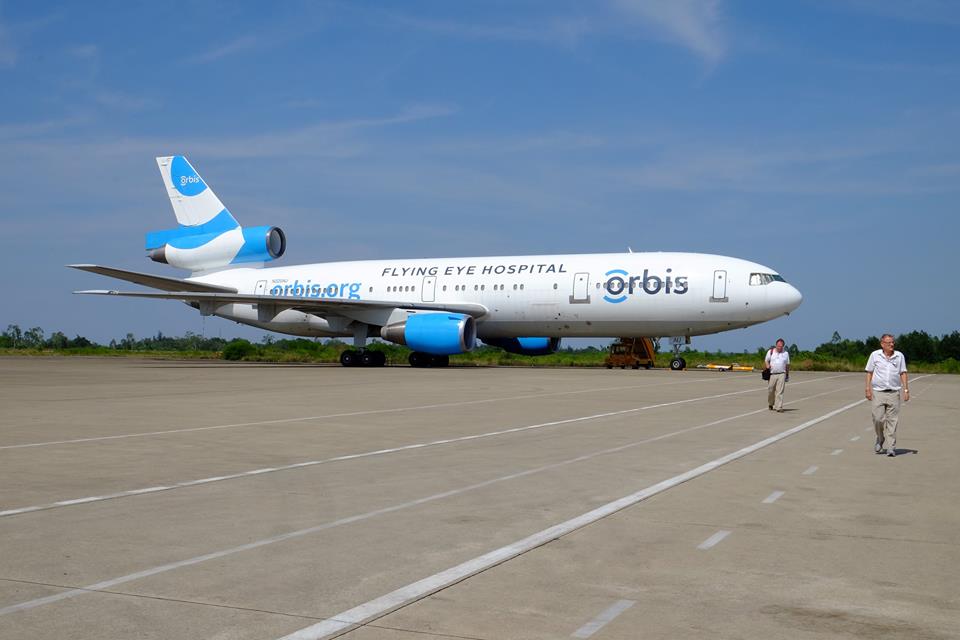[Avionics Today 10-13-2015] Orbis, the New York-based Flying Eye Hospital, is enhancing its aircraft flight tracking capabilities with a donation from Thompson Aerospace. The organization had been looking to up its ability to track its heavily modified MD-10 airliner in the remote locations the aircraft operates ahead of entering it into service, according to Bruce Johnson, director of aircraft operations at Orbis.
 |
| Orbis Flying Eye Hospital. Photo: Geoff Oliver Bugbee / Orbis |
Orbis’ MD-10 features a 48-seat classroom at the front of the aircraft, and rooms throughout the aircraft designated for laser eye examination, operations and recovery. Working in remote airspace in China, Bangladesh, Ghana and elsewhere, Orbis needed a way to enhance their aircraft tracking, Johnson told Avionics Magazine. Thompson Aerospace donated its Secure Aircraft Tracking Module (SATM) to Orbis for this purpose.
“The Thompson Secure Aerospace Global Aircraft Tracking System [SGATS] provides us with unique capabilities. Because we operate in remote locations, the SGATS provides us with unparalleled data security, meets all ICAO aircraft tracking recommendations, and allows us to follow the aircraft throughout the world in real time,” said Johnson.
Thompson completed Original Equipment Manufacturer (OEM) flight testing on the SATM in June 2015, and acquired its first Supplemental Type Certificate (STC) in September. The California-based aerospace manufacturer was looking to introduce a secure flight tracking solution that goes beyond the highly publicized 15-minute position reporting for normal flight operations recommended by the International Civil Aviation Organization (ICAO), said Mark Thompson, the company’s CEO.
“The 15-minute reporting would not have done any good for the Malaysian accident — the Malaysian aircraft reported its position every 30 minutes anyway. It’s kind of a red herring,” said Thompson. “ICAO’s recommendations also include position reporting every minute when an aircraft is operating abnormally. They also are recommending that operators have aircraft featuring systems that report the position autonomously, independent of aircraft power. If something on the aircraft happens, such as it exceeded a flight envelope condition, for example, then position reporting needs to be occurring every minute so the operator is aware of that condition. The unit you put on the plane has to be low power and able to operate without aircraft power and feature sensor equipment, to allow it to operate if the aircraft’s sensor systems stop providing it with information.”
ICAO recently published its Normal Aircraft Tracking Implementation Initiative (NATII) report, which recommended extending the applicability period for its Global Aeronautical Distress and Safety System (GADSS) flight tracking recommendations to 2018 to allow time for more clarity to be provided on the requirement, additional provisions to be developed and operators to establish implementation plans.
Thompson’s SATM has ARINC 717 Flight Data Recorder (FDR) and built-in mini Quick Access Recorder (QAR) capability, as well as an Iridium S8M transceiver with 10-hour internal standby. Thompson also has a partnership with FlightAware, which allows the SATM to track the aircraft systems’ data information in distress mode against its filed flight plan with Automatic Dependent Surveillance-Broadcast (ADS-B) data. Data transmitted from the aircraft is routed through Thompson’s ground server, which merges the data with other available airplane information such as filed flight plans, ADS-B data and nationwide radar data. The data is then securely distributed to the end user, flight operations department or any operator-specified third party.
“Because of the remote locations and high value of our mobile hospital the SGATS monitors ground activity like door openings providing us extra security and information,” said Johnson.
To bolster security, the SATM uses Federal Information Publication Standard (FIPS) 140-2 Level 3, a U.S. government security for data validity, security and access, which provides operators with the ability meet security system requirements for ISO 27001:2013, the International Security Organization (ISO) standard for information security management.
“All this information goes to the operator and with FlightAware we track the plane against the flight plan, so if the plane is off the flight plan track we would set an alert. And this is all secure from the aircraft so we know this is correct. If the ADS-B data is incorrect, we also will send an alert for that saying the ADS-B data is incorrect. This is a completely secure path that we use to move data from the aircraft into a secure network into the [Airline Operations Center] AOC network,” said Thompson.
Orbis will enter the modified MD-10 with enhanced flight tracking into service by the end of the year.